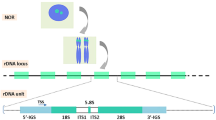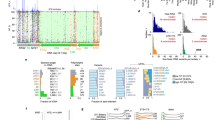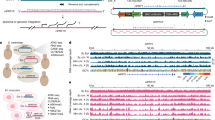Abstract
RIBOSOMAL GENES are present in many copies per cell in all living species. They are the classic example of the tandemly repeated multigene system, and have been studied in a wide variety of organisms, including man1,2, Drosophila3,4, Xenopus5,6 and Escherichia coli7. Reiteration of these genes is presumably necessary to ensure the production of the large amounts of ribosomal and 5S RNA required for use in the ribosomes. However, the possession of multiple copies of a gene poses a special problem for evolution. If a lethal or deleterious mutation occurred in one gene of, for example, the 24,000 present for the 5S DNA in Xenopus5, this would have no selective disadvantage for the organism. What then prevents the accumulation of lethal mutations in such a system? Presumably if the number of effective genes were reduced significantly natural selection would operate. But it has been suggested that a ‘correction mechanism’8 exists to maintain the homogeneity of the multigene system without a requirement for natural selection. We show here that two cloned repeats of Xenopus oocyte 5S DNA are very similar but not identical in sequence. The similarity strongly suggests that a correction mechanism is operating, but it is not so precise as to cause the different repeats to be identical. A small but distinct degree of heterogeneity is tolerated.
This is a preview of subscription content, access via your institution
Access options
Subscribe to this journal
Receive 51 print issues and online access
$199.00 per year
only $3.90 per issue
Buy this article
- Purchase on Springer Link
- Instant access to full article PDF
Prices may be subject to local taxes which are calculated during checkout
Similar content being viewed by others
References
Steffensen, D. M., Duffy, P. & Prensky, W. Nature 252, 741–743 (1974).
Henderson, A. S., Warburton, D. & Atwood, K. C. Proc. natn. Acad. Sci. U. S. A. 69, 3394–3398 (1972).
Tartoff, K. D. & Perry, P. P. J. molec. Biol. 51, 171–183 (1970).
Tartoff, K. D. & Dawid, I. B. Nature 263, 27–30 (1976).
Brown, D. D., Wensink, P. C. & Jordan, E. Proc. natn. Acad. Sci. U. S. A. 68, 3175–3179 (1971).
Brown, D. D. & Weber, C. S. J. molec. Biol. 34, 661–680 (1968).
Doolittle, W. F. & Pace, N. R. Proc. natn. Acad. Sci. U. S. A. 68, 1786–1790 (1971).
Brown, D. D., Wensink, P. C. & Jordan, E. J. molec. Biol. 63, 57–73 (1972).
Callan, H. G. J. Cell Sci. 2, 1–7 (1967).
Carroll, D. & Brown, D. D. Cell 7, 477–486 (1976).
Smith, G. P. Cold Spring Harb. Symp. quant. Biol. 38, 507–514 (1973); Science 191, 528–535 (1976).
Wegnez, M., Monier, R. & Denis, H. FEBS Lett. 25, 13–20 (1972).
Ford, P. J. & Southern, E. M. Nature new Biol. 241, 7–12 (1973).
Ford, P. J. & Brown, R. D. Cell 8, 485–493 (1976).
Fedoroff, N. V. & Brown, D. D. Cell, 13, 701–716 (1978).
Miller, J. R., Cartwright, E. M., Brownlee, G. G., Fedoroff, N. V. & Brown, D. D. Cell 13, 717–725 (1978).
Benhamou, J., Jourdan, R. & Jordan, B. R. J. molec. Evol. 9, 279–298 (1977).
Maxam, A. M. & Gilbert, W. Proc. natn. Acad. Sci. U. S. A. 74, 560–564 (1977).
Sanger, F. & Coulson, A. R. FEBS Lett. 87, 107–110 (1978).
Dayhoff, M. O. Atlas of Protein Sequence and Structure 5, 48 (1972).
Author information
Authors and Affiliations
Rights and permissions
About this article
Cite this article
MILLER, J., BROWNLEE, G. Is there a correction mechanism in the 5S multigene system?. Nature 275, 556–558 (1978). https://doi.org/10.1038/275556a0
Received:
Accepted:
Issue Date:
DOI: https://doi.org/10.1038/275556a0
Comments
By submitting a comment you agree to abide by our Terms and Community Guidelines. If you find something abusive or that does not comply with our terms or guidelines please flag it as inappropriate.



